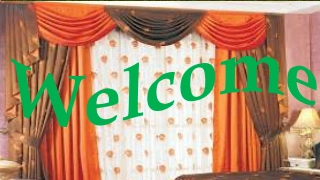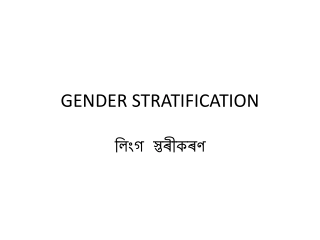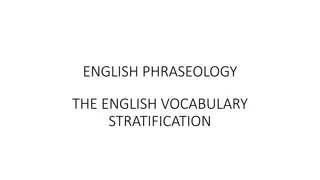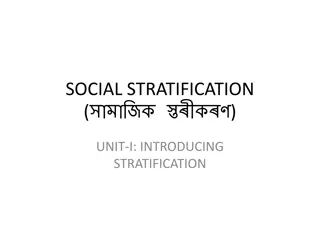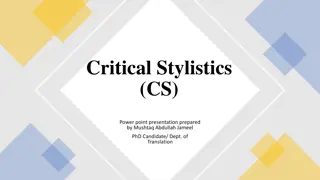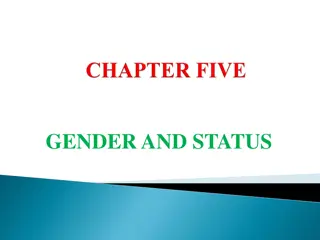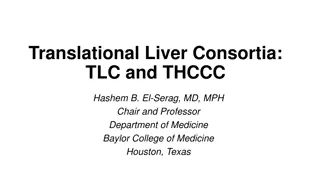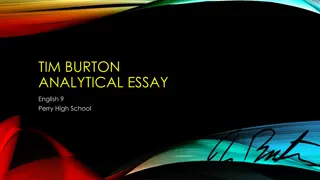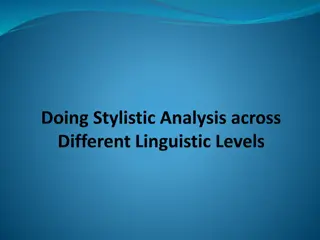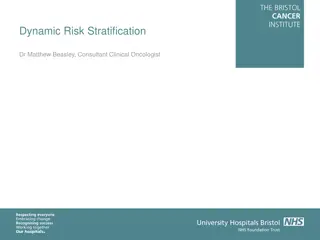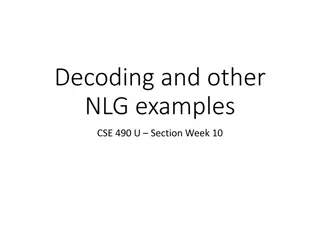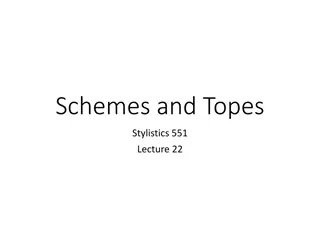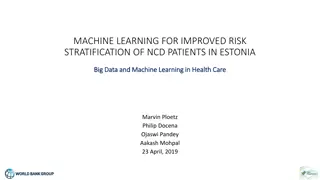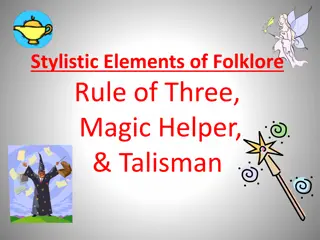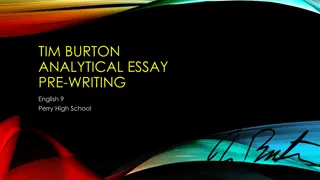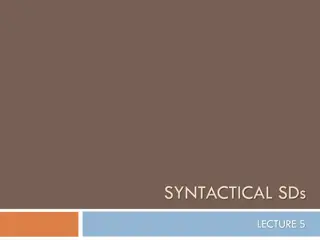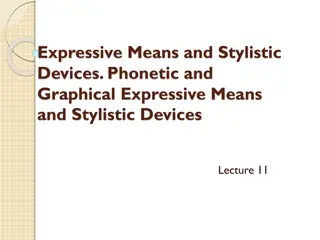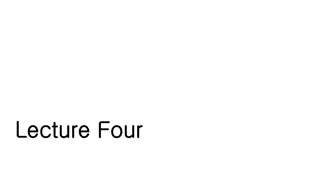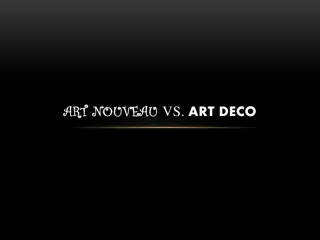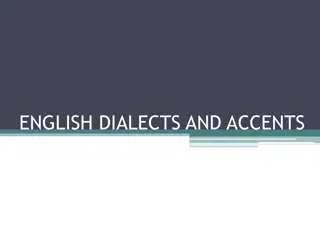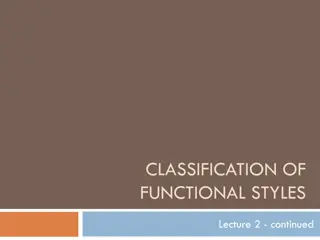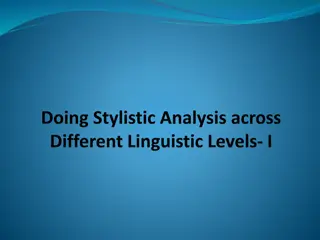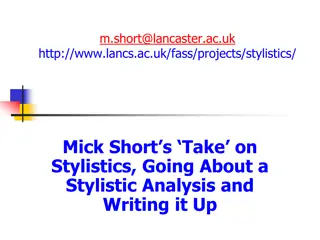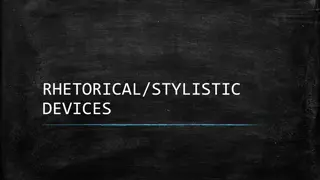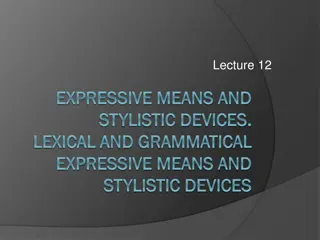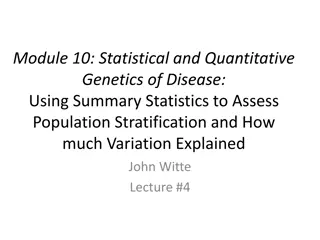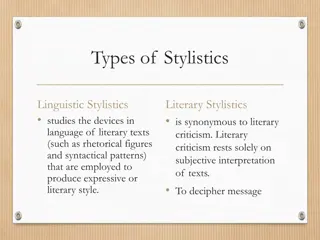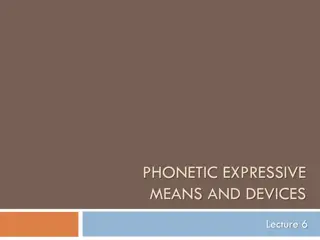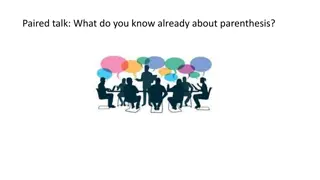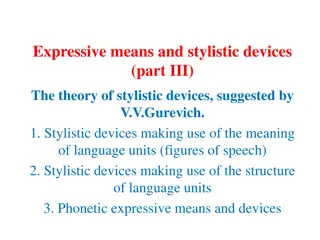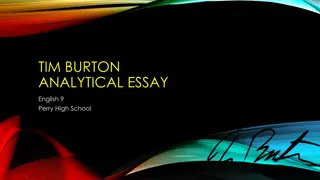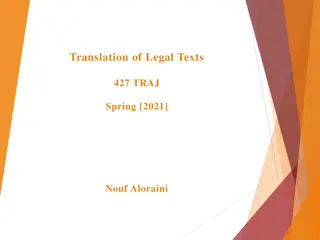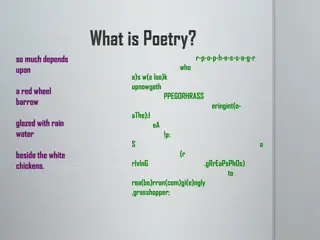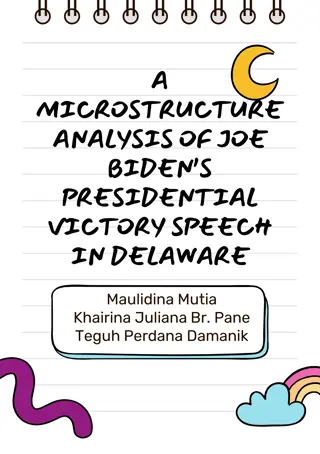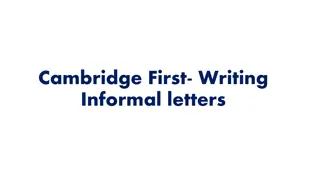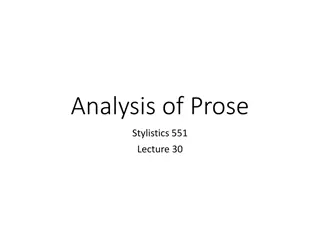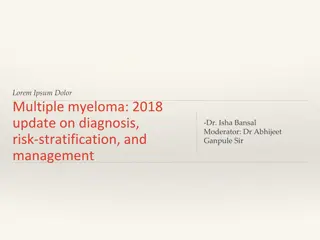Enhancing Learning through Poetry and Language Analysis
Md. Jahangir Alam, a Senior Assistant teacher at Majhira Model High School in Bogura, facilitates a learning experience focusing on appreciating stylistic elements in literary texts and developing the ability to compare individuals or objects. Through activities like comparing word meanings, explori
2 views • 13 slides
GENDER STRATIFICATION
Gender stratification involves the social ranking where men typically occupy higher statuses than women, leading to gender inequality. Feminist theory extends feminism into theoretical discourse to analyze and critique gender roles, inequalities, and patriarchy. Conflict theory is used to examine th
7 views • 8 slides
ENGLISH PHRASEOLOGY.THE ENGLISH VOCABULARY STRATIFICATION.
Explore the concept of phraseological units, various classifications, categorial features, and semantic relations in phraseology, along with the stylistic stratification of the English vocabulary, covering literary words, colloquial words, and different types of word combinations. Discover how phras
5 views • 22 slides
Overview of Stilistik in Bachelor's Studies
Stilistik in a Bachelor's program covers theoretical basics, stylistic concepts, micro and macro stylistics, and key texts in the field. It explores stylistic analysis, linguistic disciplines, communication styles, and the impact of style on various forms of expression including everyday communicati
6 views • 63 slides
An Exploration of Stylistics in Linguistics: Expressive Means and Stylistic Devices 2. Stylistics as a branch of linguistics examines expressive means and stylistic devices which enhance the emotive and aesthetic qualities of language. These include
Stylistics, Linguistics, Expressive Means, Stylistic Devices, Language
5 views • 25 slides
SOCIAL STRATIFICATION
Social stratification categorizes individuals based on factors like wealth, education, and power. Caste systems, as seen in India, are closed and ascribed by birth, while class systems are open and based on achievement. This comparison highlights the differences between the two systems and their imp
4 views • 5 slides
Understanding Critical Stylistics: Tools and Application
Critical Stylistics (CS) is a method that delves into the ideological underpinnings of texts through the analysis of linguistic features. Developed by Jeffries, CS focuses on uncovering implicit ideologies embedded in texts by examining stylistic choices. By integrating stylistics and critical disco
2 views • 28 slides
Understanding Gender Stratification and Its Impact on Society
Gender stratification is the unequal distribution of rewards, power, and prestige between men and women in society, leading to disparities in access to resources and opportunities. Men are often favored over women, resulting in fewer females in influential positions and limited decision-making power
0 views • 8 slides
Translational Liver Cancer Research Initiatives
Translational Liver Consortia (TLC) and the Translational Hepatocellular Carcinoma Consortium (THCCC) led by Dr. Hashem B. El-Serag are focused on advancing research for early detection of liver cancer. The main objectives include patient stratification for liver cancer risk, surveillance in cirrhos
0 views • 25 slides
Analyzing Tim Burton's Cinematic Style: The Anti-Hero Role in Society
Dive into the cinematic world of director Tim Burton as he intricately portrays the anti-hero's role in society through stylistic techniques in films like "The Corpse Bride" and "Charlie and the Chocolate Factory.
0 views • 28 slides
Based on the content provided, here is the information: "Stylistic Analysis & Morphology in Visual Presentation
Explore the connection between stylistic analysis and morphology in a visual context. Dive into the intricacies of form and style through a series of slides illustrating key concepts and examples.
0 views • 20 slides
Understanding Dynamic Risk Stratification in Thyroid Cancer Management
Dr. Matthew Beasley, a Consultant Clinical Oncologist, discusses the importance of Dynamic Risk Stratification in managing differentiated thyroid cancer. The process involves post-treatment monitoring through stimulated thyroglobulin (Tg) and neck ultrasound at specific intervals, aiding in determin
0 views • 16 slides
Decoding and NLG Examples in CSE 490U Section Week 10
This content delves into the concept of decoding in natural language generation (NLG) using RNN Encoder-Decoder models. It discusses decoding approaches such as greedy decoding, sampling from probability distributions, and beam search in RNNs. It also explores applications of decoding and machine tr
0 views • 28 slides
Analyzing "Icarus Flight" Through SOAPSTONE Approach
Analysis of the myth of Icarus and Daedalus through the SOAPSTONE method, focusing on the poet's perspective, stylistic elements, tone, organization, and narrative style in the poem. The poet questions Icarus' actions to prompt a deeper understanding of the consequences of flying too close to the su
0 views • 6 slides
Unveiling the Intricacies of Schemes and Tropes in Stylistics
Schemes and Tropes in classical rhetoric play a vital role in enhancing written and spoken language by deviating from literal expressions. These stylistic devices, known as figures of speech, add depth, beauty, and emotional intensity to communication. Schemes involve repetitions of expression, whil
0 views • 19 slides
Machine Learning for Improved Risk Stratification in Health Care
Explore the use of machine learning for risk stratification of patients with non-communicable diseases in Estonia. This study showcases the application of big data and machine learning in healthcare, emphasizing the benefits of personalized care, proactive disease prevention, and efficient intervent
1 views • 77 slides
Exploring Stylistic Elements of Folklore: Rule of Three, Magic Helper, and Talisman
Folklore, encompassing fairy tales and folktales, often feature stylistic elements like the Rule of Three, Magic Helper, and Talisman. The Rule of Three, a common writing strategy, creates a pattern that enhances storytelling and reader engagement. Magic Helpers, characters with extraordinary powers
2 views • 16 slides
Analyzing Tim Burton's Cinematic Style and the Anti-Hero Role
Analyze director Tim Burton's cinematic techniques and his portrayal of anti-heroes in society across his films. Explore how Burton uses stylistic elements to convey his message about the role of the anti-hero. The essay structure includes discussing anti-hero traits, challenges, and resolutions in
0 views • 21 slides
Understanding Syntactical Stylistic Devices in Literature
Syntactical Stylistic Devices (SSDs) are structural elements of language that contribute to the stylistic effect of a piece of writing, independent of its lexical content. These devices, such as inversion and detachment, play a crucial role in shaping the depth and effectiveness of literary works. C
2 views • 39 slides
Understanding Expressive Means and Stylistic Devices in Language
Expressive means and stylistic devices play a vital role in intensifying language utterances, encompassing phonetic, morphological, lexical, word-building, phraseological, and syntactical forms. These tools help evoke emotions, logical emphasis, and additional meaning in communication. By utilizing
0 views • 13 slides
Exploring Translation Techniques and Levels
Delve into various translation techniques such as amplification, false friends, explicitation, and generalization, as exemplified by Vinay and Darbelnet. Discover the concept of loss, gain, and compensation in translation, along with the different levels of translation, including lexicon, syntactic
0 views • 16 slides
Art Nouveau vs. Art Deco: A Stylistic Evolution in Design
Art Nouveau, a style prevalent from 1890 to 1914, featured intricate, flowing designs inspired by nature and a reaction to industrialization. Conversely, Art Deco, emerging in the 1920s, embraced modernism with streamlined, geometric motifs symbolizing luxury and technological progress. The transiti
0 views • 10 slides
Understanding English Dialects and Accents
Explore the rich tapestry of English dialects and accents, encompassing historical, regional, social, and stylistic variations in lexis, grammar, and pronunciation. From the distinction between dialect and accent to the social prestige of different regional varieties, delve into the complexities and
0 views • 99 slides
Understanding the Publicistic Style in Writing
The publicistic style encompasses various forms of written and oral communication, such as newspaper articles, essays, and oratorical speeches. It aims to convince and persuade the audience through a combination of logical argumentation and emotional appeal. This style utilizes a wide range of vocab
0 views • 29 slides
Exploring Stylistic Analysis and Morphology in Visual Presentation
Delve into the world of stylistic analysis and morphology through a series of visually engaging slides. Analyze the nuances of language structure and stylistic elements, enhancing your understanding of how they shape communication. The images provide a visual journey into the intricate details of li
0 views • 19 slides
Guide to Stylistic Analysis: Research and Writing Phases
Explore the essential phases of stylistic analysis - research and writing-up. Begin with thorough preparation and analysis in the research phase, followed by careful selection of key elements. Then, transition to the writing-up phase by crafting a detailed account of your insights and structuring yo
0 views • 16 slides
Exploring Rhetorical and Stylistic Devices in Speeches
Delve into the world of rhetorical and stylistic devices used in speeches, such as repetition, imagery, and devices of comparison like simile, metaphor, analogy, and juxtaposition. Understand how these devices enhance the impact and effectiveness of communication, with examples ranging from politica
0 views • 10 slides
Understanding Lexical and Grammatical Expressive Means in Stylistic Devices
The lecture discusses various lexical and grammatical expressive means in stylistic devices, such as metaphor, personification, allusion, metonymy, synecdoche, irony, epithet, and oxymoron. These tools allow for creative and vivid expressions in language by playing with different meanings and associ
0 views • 22 slides
Statistical and Quantitative Genetics of Disease: Understanding Population Stratification
This lecture explores the use of summary statistics to assess population stratification and the impact of LD on association studies in statistical and quantitative genetics. It delves into LD scores, genomic inflation, polygenic inheritance, and separating SNP heritability from population stratifica
0 views • 29 slides
Understanding Linguistic and Literary Stylistics
Linguistic Stylistics explores devices in language of literary texts to create expressive styles. Literary criticism relies on subjective interpretation, while Stylistic Analysis in linguistics identifies patterns in speech and writing. This content delves into the phonological, graphological, and l
0 views • 17 slides
Understanding Phonetic Expressive Means and Devices in Language
Phonetic expressive means and devices are utilized to enhance the acoustic effect of speech, emphasizing the utterance and evoking emotions in the audience. These tools come into play both in oral and written forms of communication, directly through intonation and stress in spoken language and indir
0 views • 36 slides
Exploring the Use of Parenthesis in Writing
Understanding the use of parenthesis in writing is crucial to convey additional information in a sentence. Parenthesis can be utilized to provide extra details about subjects and objects in various contexts, enhancing the clarity and depth of the written narrative. Additionally, different punctuatio
0 views • 9 slides
Exploring Stylistic Devices: Metaphor, Metonymy, Repetition, and More
Delve into the theory of stylistic devices proposed by V.V. Gurevich, covering figures of speech, structural devices, and phonetic expressive means. Discover examples of metaphors, metonymy, repetition techniques like anaphora and climax, along with their impact on language usage and expression.
0 views • 22 slides
Analyzing Tim Burton's Cinematic Style: The Role of Anti-Heroes in Society
Dive into Tim Burton's unique cinematic approach focusing on the portrayal of anti-heroes in society. Explore how Burton's stylistic techniques shape his argument through compelling examples from his films like "Charlie and the Chocolate Factory.
0 views • 24 slides
Translation of Legal Texts Course Overview
This course provides a comprehensive overview of translating legal texts from English into Arabic and vice versa. Students will explore various types of legal texts, specialized terminology, and resources essential for accurate translation. The course covers the history of legal discourse, emphasizi
0 views • 50 slides
Exploring Poetry: Forms, Devices, and Impact
Delve into the world of poetry and prose with an in-depth look at what sets them apart, how authors manipulate stylistic devices to evoke emotions, the significance of performance in poetry, and the role of poetry in advocating for social justice. Discover the beauty and power of poetic expression t
0 views • 13 slides
Analysis of Joe Biden's Presidential Victory Speech Microstructure in Delaware
Focused on critical discourse analysis of Joe Biden's victory speech in Delaware, this study applies qualitative research methods using van Dijk Critical Discourse Theory. The analysis reveals elements of microstructure in the speech, emphasizing linguistic aspects such as semantic, syntactic, styli
0 views • 14 slides
Mastering the Art of Writing Informal and Formal Letters
Explore the nuances of writing informal and formal letters, covering various types of letters, essential components, stylistic differences, and examples of formal versus informal expressions. Learn how to craft engaging letters for different purposes with appropriate greetings, introductions, main b
0 views • 6 slides
Understanding Stylistic Analysis in Literature
Stylistic analysis in literature involves examining linguistic features like lexis, grammar, foregrounded elements, and context to distinguish between literary and non-literary prose. While poetry allows for whole text analysis due to its brevity, prose analysis often focuses on selected extracts fo
0 views • 16 slides
Update on Multiple Myeloma: Diagnosis, Risk Stratification, and Management in 2018
Multiple myeloma is a significant hematologic malignancy with varying stages of progression. From the asymptomatic MGUS to the more advanced SMM, early diagnosis and risk stratification are crucial. The presence of myeloma defining events, specific biomarkers, and established criteria guide the diag
0 views • 40 slides
